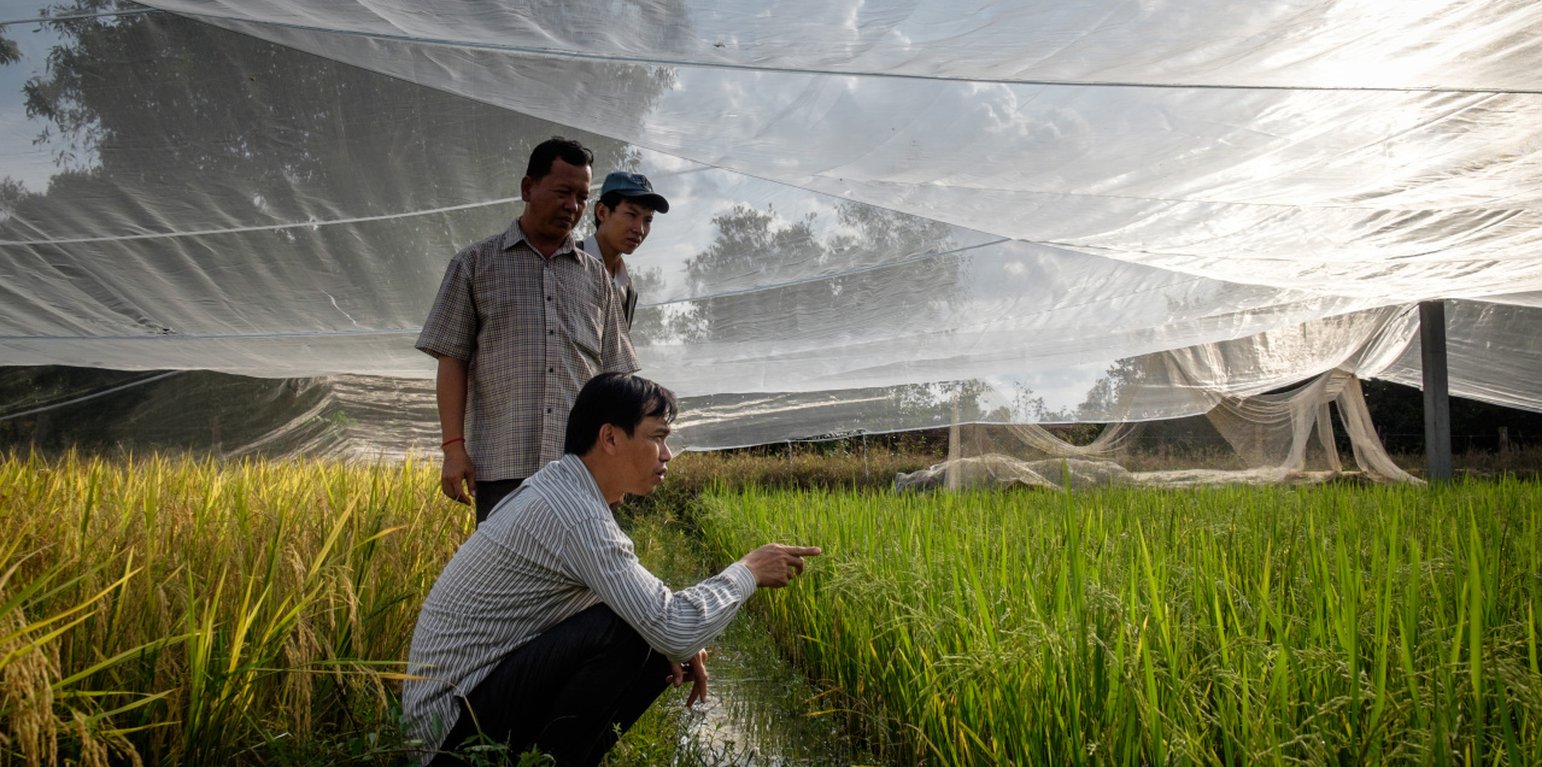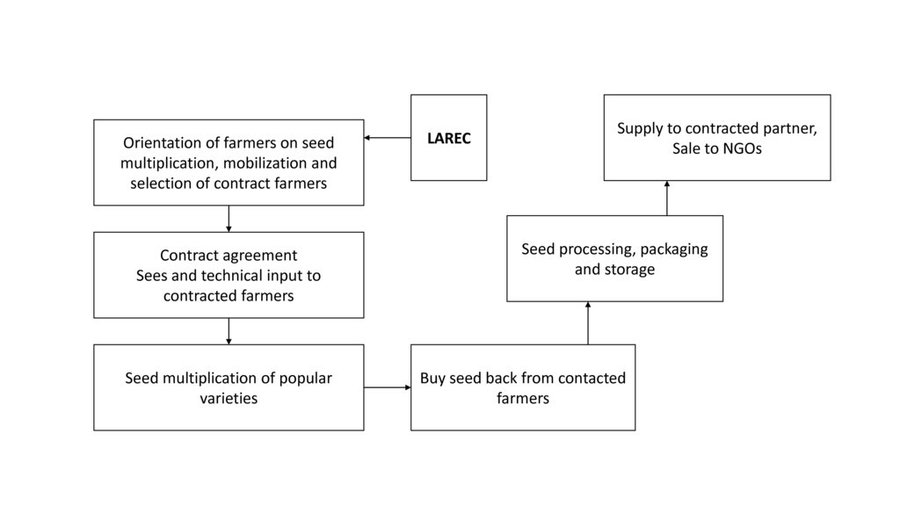Collection, selection, breeding and dissemination of locally adapted rice varieties at the Local Agricultural Research and Extension Centre LAREC.
(Cambodia)
Descripción
Local genetic rice varieties which are better adapted to changing climatic conditions are collected on farms, tested, described, selected or bred into new varieties and again distributed to farmers with the goal to increase their food security
Farmers in the central Cambodian province of Kampong Chhnang increasingly struggle with changing and unpredictable weather patterns and regular weather extremes. Lately, water supply has fluctuated annually due to alternating drought and flood extremes. Harvest yields from farmers in the region are low, amongst others, due to the use of low-quality seed, which is not adapted to local conditions, and which demands for an increase in the use of chemical fertilizers and pesticides.
Acknowledging the fact that with changing climatic conditions, local genetic resources and genetic diversity play a vital role to guarantee food security of smallholder farmers, the Local Agricultural Research and Extension Center – LAREC collects, selects, tests, breeds and disseminates rice varieties, which are better adapted to local conditions. To answer to the climate extremes of drought and flood, LAREC focusses its research on flood tolerant and drought resistant rice varieties.
Over the past years 36 flood tolerant rice varieties have been investigated by LAREC research staff for their floating ability and submergence tolerance. 6 varieties among these are: Pork Kraham, Chung Banla-6, STR010, STR10, STR 011 and Chung Banla-2, have been defined as the most appropriated varieties in term of stem elongation, submergence tolerance and yield. These are multiplied and recommended for farmers in flood prone areas.
Regarding drought tolerance LAREC bred a new variety derived from a cross between Phka Rumduol and IRRI breeding line. This variety is tested in an on farm adaptive trial to see crop performance under farmer practice. The two lines have a short growth duration range from 75 days to 90 days and are non-photo period sensitive. Besides the short growth duration, which makes them appropriate for drought prone areas, the new variety also has a desirable aroma which is important for acceptance and marketing purposes. However, to provide scientific evidence, thorough testing in on-farm trials is needed to see yield performance under farmers’ condition, seed rate application based on cultivation method and fertilizer application.
After the production of basic seed for rice LAREC distributes the seed to contract farmers for multiplication under the supervision of LAREC staff. The multiplied seed is distributed to interested buyers through LAREC and the local farmers' associations.
Lugar
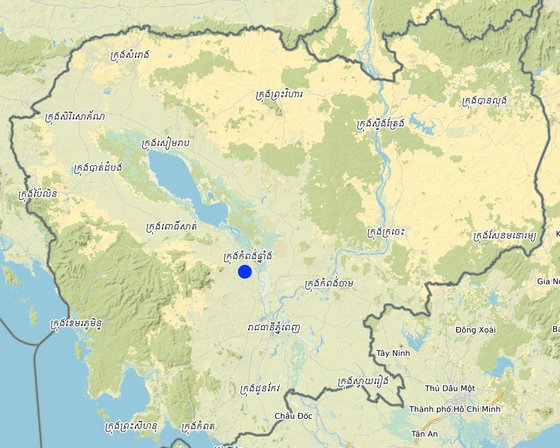
Lugar: Rolea Pha-ear, Kampong Chhnang, Cambodia
Georreferencia de sitios seleccionados
Dato de inicio: 2010
Año de conclusión: n.d.
Tipo de Enfoque
-
tradicional/ local
-
iniciativa local reciente/ innovadora
-
proyecto/ basado en un programa
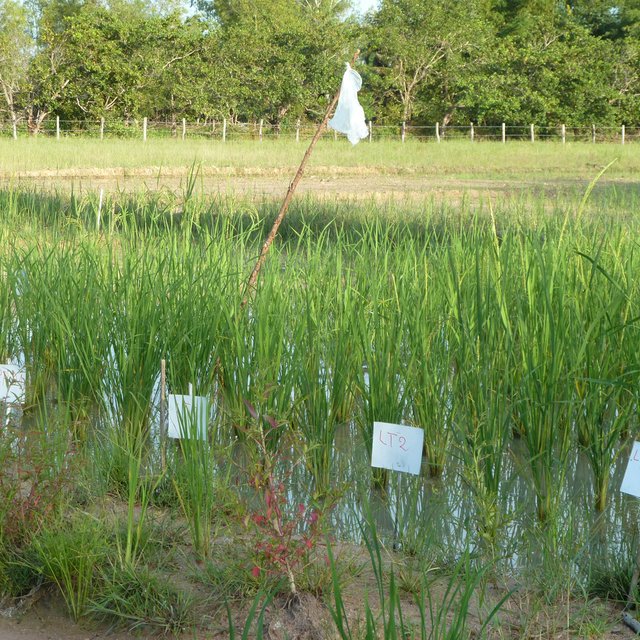
LAREC rice test fields (HEKS)
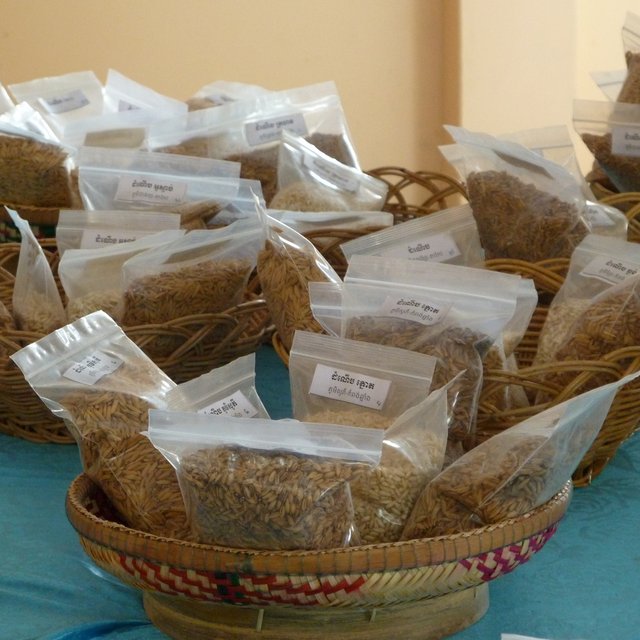
Local rice varieties collected for testing (HEKS)
Metas del Enfoque y entorno facilitador
Propósitos/ objetivos principales del Enfoque
Provide high quality seeds of local varieties which are better adapted to changing climatic conditions to the farmers in the area.
Condiciones que facilitan la implementación de la/s Tecnología/s aplicadas bajo el Enfoque
-
Normas y valores sociales/ culturales/ religiosos: The founding of LAREC as a local research station was needs-based, as a consequence of increasing exposure of farmer's rice yields to extreme weather events (drought and flood)
-
Disponibilidad/ acceso a recursos y servicios financieros : The building up of LAREC (warehouse, office building, greenhouse, drying site, trial field) was rendered possible due to funding by SOFDEC/HEKS
-
Conocimiento de MST, acceso a apoyo técnico: Highly specialized research personnel working with local varieties adapted to local conditions
Condiciones que impiden la implementación de la/s Tecnología/s aplicadas bajo el Enfoque
-
Normas y valores sociales/ culturales/ religiosos: Farmers are consulted in the selection of seed varieties, but not engaged in the research process.
There is a certain degree of aversion towards local varieties by the farmers, due to lower yields.
-
Conocimiento de MST, acceso a apoyo técnico: Only limited knowledge transfer to farmers, as research is conducted in the center, not through a participatory breeding approach
-
Mercados (para comprar insumos, vender productos) y precios: LAREC struggels to become self-sustained by selling the seeds on the local market.
Participación y roles de las partes interesadas involucradas
Partes interesadas involucradas en el Enfoque y sus roles
| ¿Qué partes interesadas/ entidades implementadoras estuvieron involucradas en el Enfoque? |
Especifique las partes interesadas |
Describa los roles de las partes interesadas |
| usuarios locales de tierras/ comunidades locales |
Farmers |
Farmers are involved in the selection of seeds and some contracted farmers act as seed multipliers for LAREC |
| organizaciones comunitarias |
Community committees |
They play a role to facilitate and promote the seed produced by LAREC. They also support the selection of seeds and follow up on the contracting farmers |
| investigadores |
LAREC reserach personnel |
Selection, testing, breeding of adapted varieties |
| ONG |
SOFDEC
HEKS (Swiss Church Aid) |
SOFDEC provided 100% of the funding. SOFDEC staff links LAREC to the farmers and support the collection, dissemination promotion of the seeds and are also collecting feedback from farmers for discussion with LAREC team to find the solution.
HEKS (Swiss Church Aid) is the main backdonor of SOFDEC and hence of LAREC. |
| gobierno nacional (planificadores, autoridades) |
Cambodian Agricultural Research and Development Institute (CARDI) |
CARDI plays an advisory role and also supports the promotion of LAREC.
LAREC is linked to CARDI to exchange on seed multiplication |
Involucramiento de los usuarios locales de tierras/ comunidades locales en las distintas fases del Enfoque
ninguno
pasivo
apoyo externo
interactivo
auto-movilización
iniciación/ motivación
LAREC was initiated by SOFDEC, as a consequence of an increasing exposure of farmer's rice yields to weather extremes (drought/flood)
planificación
Planning of the center by SOFDEC
implementación
LAREC collects seed varieties on farms, tests, selects, breeds and disseminates seed again to farmers.
Farmers do the multiplication of seeds and use the adapted varieties for their rice production (own consumption and for the market)
monitoreo y evaluación
M+E is conducted by LAREC, SOFDEC and HEKS ((internally) as well as by external evaluators (at the end of each project phase)
Research
Selection of promising varieties is done in consultation with the farmers.
Research with the selected crops is done entirely on the LAREC site.
Flujograma
Organizational chart of LAREC seed multiplication
La toma de decisiones en la selección de Tecnología MST
Las decisiones fueron tomadas por
-
solamente usuarios de tierras (autoiniciativa)
-
principalmente usuarios de tierras con el apoyo de especialistas MST
-
todos los actores relevantes, como parte de un enfoque participativo
-
principalmente por especialistas MST en consulta con usuarios de tierras
-
solo por especialistas MST
-
por políticos/ líderes
La toma de decisiones se basa en
-
la evaluación de conocimiento MST bien documentado (la toma de decisiones se basa en evidencia)
-
hallazgos de investigaciones
-
la experiencia personal y opiniones (no documentadas)
Apoyo técnico, fortalecimiento institucional y gestión del conocimiento
Las siguientes actividades o servicios fueron parte del enfoque
-
Construcción de capacidades / capacitación
-
Servicio de asesoría
-
Fortalecimiento institucional (desarrollo institucional)
-
Monitoreo y evaluación
-
Investigación
Construcción de capacidades/ capacitación
Se proporcionó capacitación a las siguientes partes interesadas
-
usuarios de tierras
-
personal de campo/ consejeros
Forma de capacitación
-
en el contexto de trabajo
-
de agricultor a agricultor
-
áreas de demostración
-
reuniones públicas
-
cursos
Temas avanzados
Contract farmers are trained on seed production and seed storage.
Fortalecimiento institucional
Se fortalecieron/ establecieron instituciones
-
no
-
sí, un poco
-
sí, moderadamente
-
sí, mucho
Describa la institución, los roles y las responsabilidades, miembros, etc.
Establishment of a local agricultural research center
Tipo de apoyo
-
financiero
-
construcción de capacidades/ entrenamiento
-
equipo
Detalles adicionales
Monitoreo y evaluación
Yearly monitoring of number of land users using selected of new varieties. Ad-hoc measurements of yield (carried out by project staff)
Investigación
La investigación trató los siguientes temas
-
sociología
-
economía/ marketing
-
ecología
-
tecnología
Research to select and improve local rice varieties to be better adapted to changing climatic conditions is the main activity of the approach.
Financiamiento y apoyo material externo
Presupuesto anual en dólares americanos para el componente MST
-
< 2,000
-
2,000-10,000
-
10,000-100,000
-
100,000-1,000,000
-
> 1,000,000
Precise annual budget: n.d.
Los siguientes servicios o incentivos fueron proporcionados a los usuarios de las tierras
-
Apoyo financiero/material proporcionado a los usuarios de tierras
-
Subsidios para insumos específicos
-
Crédito
-
Otros incentivos o instrumentos
parcialmente financiado
totalmente financiado
equipo: maquinaria: herramientas
El trabajo de los usuarios de las tierras fue
-
voluntario?
-
comida por trabajo?
-
pagado en efectivo?
-
recompensado con otro tipo de apoyo material?
Análisis de impacto y comentarios de conclusión
Impactos del Enfoque
No
Sí, un poco
Sí, moderadamente
Sí, mucho
¿El Enfoque ayudó a los usuarios de tierras a implementar y mantener Tecnologías MST?
Farmers have access to seed varieties which are adapted to local conditions (e.g. drought and flood resistance), ensuring that yields are also generated in case of an extreme weather event.
¿El Enfoque resultó en mejor seguridad alimentaria/ mejoró la nutrición?
Through the use of seed varieties which are adapted to local conditions, (e.g. drought and flood resistance) farmers increase their food security by ensuring that yields are also generated in case of an extreme weather event. Farmers are more resilient against extreme weather events.
¿El Enfoque mejoró la capacidad de los usuarios de tierras a adaptarse a los cambios climáticos/ extemos y mitigar desastres relacionados al clima?
Through the use of seed varieties which are adapted to local conditions, (e.g. drought and flood resistance) farmers increase their food security by ensuring that yields are also generated in case of an extreme weather event. Farmers are more resilient against extreme weather events.
¿El Enfoque llevó a oportunidades de empleo, ingresos?
Additional income for contract farmers through seed multiplication
Motivación principal del usuario de la tierra para implementar MST
-
producción incrementada
-
incremento de la renta(bilidad), proporción mejorada de costo-beneficio
-
reducción de la degradación de la tierra
-
reducción del riesgo de desastres naturales
-
carga de trabajo reducida
-
pagos/ subsidios
-
reglas y reglamentos (multas)/ aplicación
-
prestigio, presión social/ cohesión social
-
afiliación al movimiento/ proyecto/ grupo/ redes
-
conciencia medioambiental
-
costumbres y creencias, moral
-
conocimiento y capacidades mejorados de MST
-
mejoramiento estético
-
mitigación de conflicto
Sostenibilidad de las actividades del Enfoque
¿Pueden los usuarios de tierras sostener lo que se implementó mediante el Enfoque (sin apoyo externo)?
Conclusiones y lecciones aprendidas
Fortalezas: perspectiva del usuario de tierras
-
Seeds of high quality are provided by LAREC.
-
Quality of crops from LAREC-seed is uniform and varieties are demanded on the market, thus contributing to an increasing farmer income.
-
Increased food-security as adapted seeds also perform in the likelihood of an extreme weather event.
Fortalezas: punto de vista del compilador o de otra persona recurso clave
-
Seeds are collected in the region from the farmers, thus adapted to the local conditions. (They are collected in the research center and in addition the center buys foundation seeds from the Cambodian Agricultural Research and Development Institute (CARDI) in order to scale up).
Debilidades/ desventajas/ riesgos: perspectiva del usuario de tierrascómo sobreponerse
Debilidades/ desventajas/ riesgos: punto de vista del compilador o de otra persona recurso clavecómo sobreponerse
-
Farmers are still dependent on getting new seeds of the selected varieties (every 3 years for rice) as seeds get mixed and cross pollination occurs.
-
Lack of money to store the seeds in a proper way. Lack of material (silica gel, oven).
Find external financing sources. Connect with international seed saving organisations if collection and distribution of local ecotypes gets a higher priority.
-
Breeding and selection is not happening on-farm, only at the LAREC centre. Land users remain highly dependent on LAREC to provide new seeds every few years.
Implement participatory plant breeding. Train farmers in selection (already happening with mung bean and rice) and breeding.
Referencias
Editors
-
Christine Lottje
-
Christoph Kaufmann
-
Stefan Graf
-
Judith Macchi
Revisado por
-
Judith Macchi
-
Alexandra Gavilano
-
Boris Orlowsky
Fecha de la implementación: 17 de febrero de 2017
Últimas actualización: 12 de marzo de 2021
Personas de referencia
-
Lean Hak Khun (kleanghak@yahoo.com) - Especialista MST
-
Khonhel Pith (khonhel@gmail.com) - Especialista MST
Descripción completa en la base de datos de WOCAT
La documentación fue facilitada por
Referencias claves
-
Paris, T., et al. 2011. Guide to participatory varietal selection for submergence-tolerant rice. IRRI: www.irri.org
Vínculos a la información relevante disponible en línea
- The Society for Community Development in Cambodia (SOFDEC) is a Cambodian Non-Governmental Organization, established in 2006 through the localization of HEKS (the Swiss Church Aid) project in Kampong Chhnang province, Cambodia. The vision of SOFDEC is that Cambodian people living in Cambodia live a state of comfort, equality, equity, and have ownership over the sustainable development of their community. The mission of SOFDEC works in partnership with community based organizations and relevant institutions through integrated community development, research, human resource development, enhancement of family economies, in the hopes to uplift the living standards of the people in the target areas. Our goal aims to uplift the living standards of the rural people of Cambodia through the improvement in income generation, sustainable agricultural practices, microfinance, health, human resource development, and sustainable natural resource management.: www.sofdec.com
